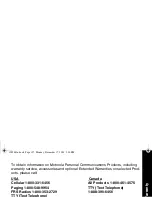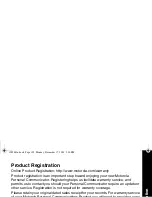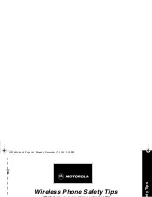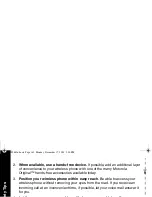
F
D
A
Upd
a
te f
o
r Mobi
le Phones
147
People who must conduct extended conversations in their cars every day could
switch to a type of mobile phone that places more distance between their bodies and
the source of the RF, since the exposure level drops off dramatically with distance.
For example, they could switch to:
•
a mobile phone in which the antenna is located outside the vehicle,
•
a hand-held phone with a built-in antenna connected to a different antenna
mounted on the outside of the car or built into a separate package, or
•
a headset with a remote antenna to a mobile phone carried at the waist.
Again, the scientific data
do not
demonstrate that mobile phones are harmful. But if
people are concerned about the radiofrequency energy from these products, taking
the simple precautions outlined above can reduce any possible risk.
Where can I find additional information?
For additional information, see the following websites:
Federal Communications Commission
(FCC) RF Safety Program (select
“Information on Human Exposure to RF Fields from Cellular and PCS Radio
Transmitters”): http://www.fcc.gov/oet/rfsafety
World Health Organization
(WHO) International Commission on Non-Ionizing
Radiation Protection (select Qs & As): http://www.who.int/emf
United Kingdom, National Radiological Protection Board
:
http://www.nrpb.org.uk
1039b80o.book Page 147 Monday, December 17, 2001 2:00 PM
Summary of Contents for V101
Page 1: ...1039b80o book Page 1 Monday December 17 2001 2 00 PM ...
Page 2: ...1039b80o book Page 2 Monday December 17 2001 2 00 PM ...
Page 29: ...d 1039b80o book Page 25 Monday December 17 2001 2 00 PM ...
Page 139: ...Questions 1039b80o book Page 135 Monday December 17 2001 2 00 PM ...
Page 165: ...ty Tips Wireless Phone Safety Tips 1039b80o book Page 161 Monday December 17 2001 2 00 PM ...
Page 176: ...1039b80o book Page 172 Monday December 17 2001 2 00 PM ...
Page 177: ...1039b80o book Page 173 Monday December 17 2001 2 00 PM ...
Page 178: ...0 1039b80o book Page 174 Monday December 17 2001 2 00 PM ...


































